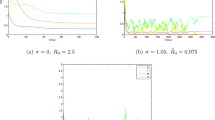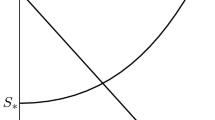Abstract
The dynamical properties of a stochastic susceptible-infected epidemic model with Logistic growth are investigated in this paper. We show that the stochastic model admits a nonnegative solution by using the Lyapunov function method. We then obtain that the infected individuals are persistent under some simple conditions. As a consequence, a simple sufficient condition that guarantees the extinction of the infected individuals is presented with a couple of illustrative examples.
Similar content being viewed by others
1 Introduction
Some mathematical models, for instance, see [1–5], have been employed to describe and understand epidemic transmission dynamics since the work of Kermack and McKendrick [6] was proposed. The classical compartment models were proposed and investigated on the ground of some restrictive assumptions including a constant total population size and a constant recruitment rate for the susceptible individuals. This assumption is relatively reasonable for a short-lasting disease. While in reality, the population sizes of human beings and other creatures are generally variable, instead of keeping constant for a long run. As an example of this phenomenon, Ngonghala et al. pointed out that malaria in developing countries took place with growth of local population size. When it concerns the variable population size, some recent literature works, such as Ngonghala et al. [7], Busenberg and Driessche [8], Wang et al. [9], Zhao et al. [10], Zhu and Hu [11], Li et al. [12], had considered the effect of population size on the epidemic dynamics. We would like to mention the work by Wang et al. [9], in which they constructed an SIS epidemic model under the assumption that the susceptible individuals followed the Logistic growth:
where \(S(t)\) and \(I(t)\) denote the numbers of the susceptible and the infected individuals at time t, respectively; r is the intrinsic growth rate of the susceptible individuals; a is the carrying capacity of the community in the absence of infection; d is the natural death rate; γ represents the recovery rate of the infected individuals; ε is the disease-induced death rate; \(\beta(I)\) is the transmission rate and is given in the following form:
All the parameters are assumed to be nonnegative. When \(p=0\), \(\beta(I)\) is equal to the constant transmission rate β. In this paper, we shall consider the following deterministic SIS endemic model:
where \(b=r/a\). We set \(N(t)\) is the total population at time t, then
Wang et al. [9] showed that the domain
is a positively invariant set with respect to model (1). Moreover, the disease-free equilibrium \(E_{0}(a,0)\) of model (1) always exists, and if the basic reproductive number
\(E_{0}(a,0)\) is globally asymptotically stable. If \(R_{0}>1\), then \(E_{0}(a,0)\) is unstable, and there is a unique endemic equilibrium \(E^{*}(S^{*},I^{*})\) which is globally asymptotically stable. Here
The compartment models are inevitably affected by the environmental noise. We assume that the transmission coefficient β is subject to the environmental white noise, that is,
where \(B(t)\) is a standard Brownian motion, σ is the intensity of environmental white noise. In order to explore the stochastic effect, when the constant transmission rate is replaced by a random variable, we consider the corresponding stochastic SIS epidemic model:
The sum of the two equations for the population size \(N(t)\) of models (3) and (9) is
Throughout this paper, we will work on the complete probability space \((\Omega, \{\mathcal{F}_{t}\}_{t\geq 0},P)\) with its filtration \(\{\mathcal{F}_{t}\}_{t\geq 0}\) satisfying the usual conditions (i.e., it is right continuous and \(\mathcal{F}_{0}\) contains all P-null sets). We will investigate the dynamical properties of stochastic SIS model from several aspects: the result that stochastic model (9) admits a unique positive solution will be studied in the next section. The sufficient conditions of the persistence for the infected individuals would be derived. Further, we still find a simple condition to reach the extinction for the infected individuals. As a consequence, several illustrative examples are carried out to support the main results of this paper.
2 Existence and uniqueness of positive solution
In this section, we first show that the solution of system (9) is positive and global. Our proof is motivated by the work of Mao et al. [13].
Theorem 1
There exists a unique solution \((S(t),I(t))\) of system (9) on \(t\geq 0\) for any initial value \((S(0),I(0))\in \mathbb{R}^{2}_{+}\), and the solution will remain in \(\mathbb{R}^{2}_{+}\) with probability 1, namely \((S(t),I(t))\in \mathbb{R}^{2}_{+} \) for all \(t\geq 0\) almost surely.
Proof
Since the coefficients of model (9) satisfy local Lipschitz conditions for any initial value \((S(0),I(0))\in \mathbb{R}^{2}_{+}\), there exists a unique local solution on \(t\in[0,\tau_{e})\), where \(\tau_{e}\) is the explosion time. Next, we will show that the solution of model (9) is global. To this end, we need to show that \(\tau_{e}=\infty\) holds almost surely. Let \(k_{0}>0\) be sufficiently large such that \(S(0)\) and \(I(0)\) all lie within the interval \([\frac{1}{k_{0}}, k_{0}]\). For all \(k\geq k_{0}\), we define the stopping time
Throughout this paper, we set \(\inf\emptyset=\infty\). Clearly, \(\tau_{k}\) is an increasing function as \(k\rightarrow\infty\). We set \(\tau_{\infty}=\lim_{k\to \infty} \tau_{k}\), according to the definition of stopping time, we get that \(\tau_{\infty}\leq\tau_{e}\) a.s. If we can show that \(\tau_{\infty}=\infty \) a.s., then \(\tau_{e}=\infty\) a.s. From now on, our proof will go by contradiction. If this statement is false, then there exists a pair of constants \(T>0\) and \(\varepsilon\in(0,1)\) such that \(P\{\tau_{\infty}\leq T\}>\varepsilon\), hence there exists an integer \(k_{1}>k_{0}\) such that
We define a \(C^{2}\)-function \(V:\mathbb{R}^{2}_{+}\rightarrow\mathbb{R}_{+}\) as follows:
where k is a constant determined later. Generalized Itô's formula gives that
Choose the constant
which implies that
The remainder of the proof follows that in Zhao et al. [10]. □
3 Persistence in the mean
In this section, we shall investigate the persistence property of model (9). The solution of model (9) is said to be persistent in the mean if
For convenience, we define the following notation:
Lemma 1
([13], Strong law of large numbers)
Let \(M=\{M_{t}\}_{t\geq0}\) be a real-valued continuous local martingale vanishing at \(t=0\). Then
and also
Theorem 2
Let \((S(t), I(t))\) be a solution of system (9) with any initial value \((S(0),I(0))\in \Pi\). If
then the density of the infected individuals obeys the following expression:
Proof
Integrating both sides of the second equation of model (9) gives that
Then generalized Itô's formula acting on model (9) leads to
Integrating both sides of (24) and (25) from 0 to t and dividing by t, we have that
We combine (23), (26), and (27) and derive that
then
We denote
by strong law of large numbers for martingales, together with the facts \(0< S(t)\), \(I(t)< K_{0}\), which yields that
therefore,
The proof is complete. □
Example 1
Let the parameters of model (9) be
and the initial value be \((S(0),I(0))=(5,2)\), then the threshold of model (9) is computed as
which is consistent with the result of Theorem 2 (see Fig. 1).
4 Extinction
In the previous section, we have investigated the persistence of the solution to model (9). In this section, we shall prove that the density of the infected individuals will be driven to extinction with a negative exponential power under some simple assumptions.
Theorem 3
Let \((S(t), I(t))\) be the solution of model (9) with the initial value \((S(0),I(0))\in \Pi\). If
or
holds, then the density of the infected individuals will decline to zero exponentially with probability one. That is to say,
or
Proof
From the second equation of model (9), we have
The fact \(S\leq K_{0}\) leads to the following result:
We denote
by the strong law of large numbers for martingales, we then have
Condition (35) of Theorem 3 gives that
On the other hand, expression (39) can be computed as follows:
By similar discussion, together with condition (36), we take superior limit on both sides of (44) and derive that
The proof is complete. □
Example 2
We set the parameters of model (9) are
and the initial value is \((S(0),I(0))=(35,50)\). It is easy to check that
Theorem 3 is satisfied, and the infected individuals will decline to zero according to Fig. 2. If we choose another group of parameters
and the initial value \((S(0),I(0))=(1,8)\) in order to meet condition (36), after substitution, we then get that
which also means that the infected individuals definitely tend to zero with the rate of a negative exponential power as shown in Fig. 3.
The infected individuals are extinct under condition (35)
The density of the infected individuals approaches zero almost surely under condition (36)
5 Conclusion
The dynamical properties of the stochastic SIS model with Logistic growth are paid more attention to in this paper. According to the approach shown in many recent literature works, we still construct a \(C^{2}\)-function to show that the stochastic SIS epidemic model admits a unique positive global solution. Based on the general assumption of this paper, the total population is separated into two compartments: one is the susceptible, another is the infected. We also assume that the transmission rate β is perturbed by a white noise. The two indicators \(\tilde{R}_{0}\) and \(\breve{R}_{0}\) are kind of thresholds of this paper: when \(\tilde{R}_{0}> 1\), under some extra conditions, the density of the infected individuals keeps persistent; when \(\breve{R}_{0}<1\) holds or (36) is valid, the density of the infected individuals declines to zero in a long run. Several illustrative examples support the main results of this paper.
References
Tchuenche, J., Nwagwo, A., Levins, R.: Global behaviour of an SIR epidemic model with time delay. Math. Methods Appl. Sci. 30(6), 733–749 (2007)
Chen, H., Sun, J.: Global stability of delay multigroup epidemic models with group mixing and nonlinear incidence rates. Appl. Math. Comput. 218(8), 4391–4400 (2011)
Teng, Z., Wang, L.: Persistence and extinction for a class of stochastic SIS epidemic models with nonlinear incidence rate. Physica A 451, 507–518 (2016)
Liu, Q., Chen, Q.: Dynamics of a stochastic SIR epidemic model with saturated incidence. Appl. Math. Comput. 282, 155–166 (2016)
Zhao, D.: Study on the threshold of a stochastic SIR epidemic model and its extensions. Commun. Nonlinear Sci. Numer. Simul. 38, 172–177 (2016)
Kermack, W.O., McKendrick, A.G.: A contribution to the mathematical theory of epidemics. Proc. R. Soc. Lond. Ser. A, Math. Phys. Sci. 115(772), 700–721 (1927)
Ngonghala, C., Teboh-Ewungkem, M., Ngwa, G.: Persistent oscillations and backward bifurcation in a malaria model with varying human and mosquito populations: implications for control. J. Math. Biol. 70(7), 1581–1622 (2015)
Busenberg, S., Van den Driessche, P.: Analysis of a disease transmission model in a population with varying size. J. Math. Biol. 28(3), 257–270 (1990)
Wang, L., Zhou, D., Liu, Z., Xu, D., Zhang, X.: Media alert in an SIS epidemic model with logistic growth. J. Biol. Dyn. 11(1), 120–137 (2017)
Zhao, Y., Jiang, D., Mao, X., Gray, A.: The threshold of a stochastic SIRS epidemic model in a population with varying size. Discrete Contin. Dyn. Syst., Ser. B 20(4), 1277–1295 (2015)
Zhu, L., Hu, H.: A stochastic SIR epidemic model with density dependent birth rate. Adv. Differ. Equ. 2015, 1 (2015)
Li, X., Gray, A., Jiang, D., Mao, X.: Sufficient and necessary conditions of stochastic permanence and extinction for stochastic logistic populations under regime switching. J. Math. Anal. Appl. 376(1), 11–28 (2011)
Mao, X., Marion, G., Renshaw, E.: Environmental Brownian noise suppresses explosions in population dynamics. Stoch. Process. Appl. 97(1), 95–110 (2002)
Acknowledgements
The authors would like to thank Zhanshuai Miao for his discussion and the anonymous referees for their good comments. This work is supported by the National Natural Science Foundation of China (Grant Nos. 11201075, 11601085), Natural Science Foundation of Fujian Province of China (Grant No. 2016J01015, 2017J01400).
Author information
Authors and Affiliations
Contributions
The main idea of this paper was proposed by JL. JL prepared the manuscript initially, LC and FW performed all the steps of the proofs in this research. All authors read and approved the final manuscript.
Corresponding author
Ethics declarations
Competing interests
We claim that none of the authors have any competing interests in the manuscript.
Additional information
Publisher's Note
Springer Nature remains neutral with regard to jurisdictional claims in published maps and institutional affiliations.
Rights and permissions
Open Access This article is distributed under the terms of the Creative Commons Attribution 4.0 International License (http://creativecommons.org/licenses/by/4.0/), which permits unrestricted use, distribution, and reproduction in any medium, provided you give appropriate credit to the original author(s) and the source, provide a link to the Creative Commons license, and indicate if changes were made.
About this article
Cite this article
Liu, J., Chen, L. & Wei, F. The persistence and extinction of a stochastic SIS epidemic model with Logistic growth. Adv Differ Equ 2018, 68 (2018). https://doi.org/10.1186/s13662-018-1528-8
Received:
Accepted:
Published:
DOI: https://doi.org/10.1186/s13662-018-1528-8







